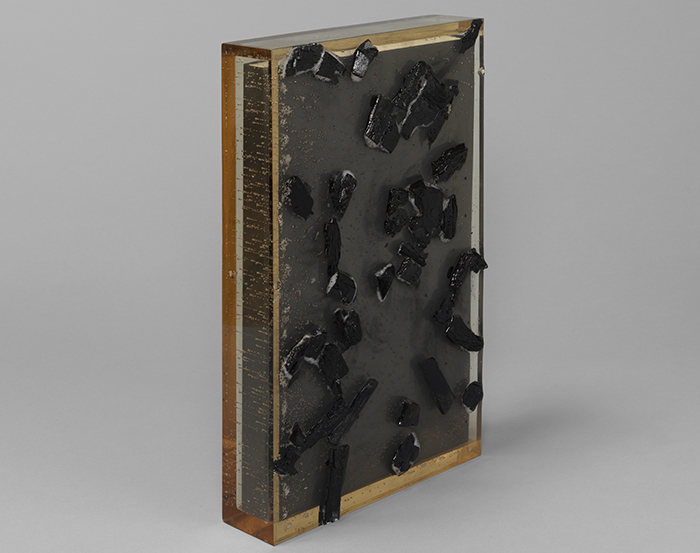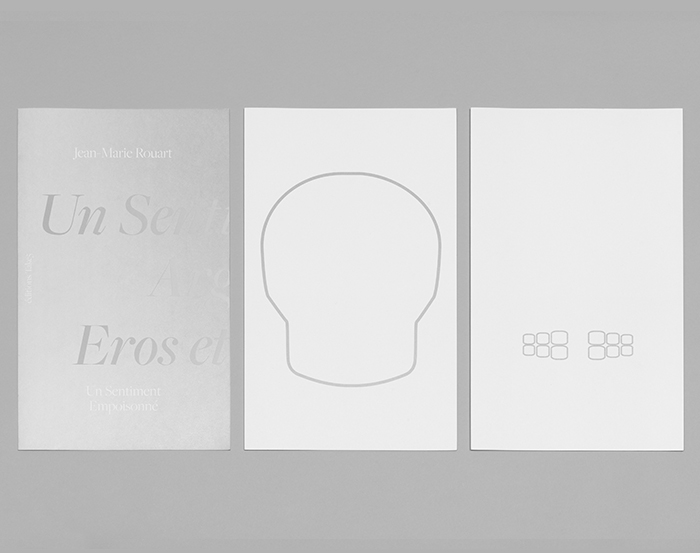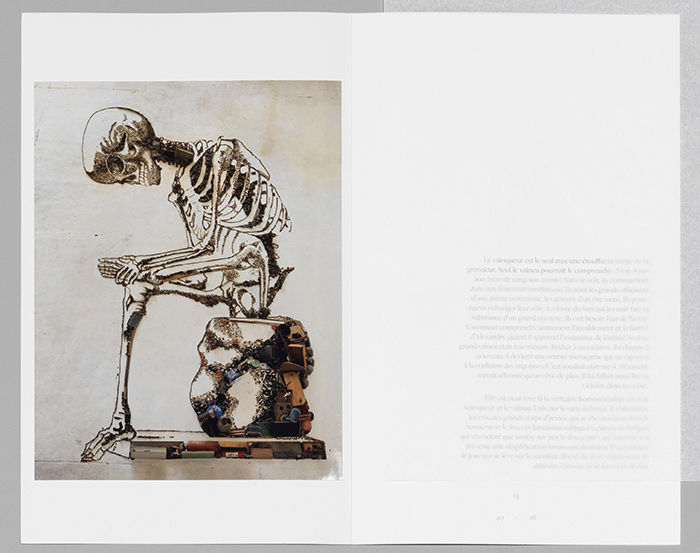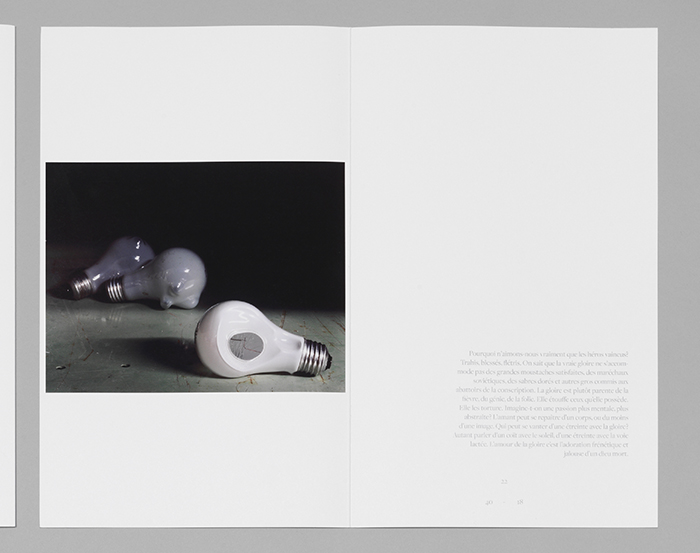
A POISONED FEELING
Artists' book published in 2016 by Editions Take5 (Geneva).An original text written in French for the book by Jean-Marie Rouart
illustrated by 11 original photographs by the following artists :
Valérie Belin - James Casebere - Mat Collishaw - Tim Davis -
Mounir Fatmi – Eric Poitevin - Evangelia Kranioti - David Levinthal –
Polly Morgan – Vik Muniz - Angélique Stehli
and an embossed pattern by John Armleder
Graphic design by Gina Donzé for Base Studio Geneva, and Céline Fribourg
Traycase designed by Piergiorgio Robino for Studio Nucleo
and handmade in resin, carbon and ash
A separate sewn-booklet includes a translation into English of the text,
by Peter Doherty, as well as philosophical and literary quotes chosen
by the artists
Each copy is numbered and signed by all the artists
All the photographs are signed
Dimensions: 18 x 11,2 x 2 inches - An edition of 35 copies

In A Poisoned Feeling, Jean-Marie Rouart examines our relation to death.
As a symbol, death is the perishable, destructible facet of existence. It indicates what disappears in the ineluctable evolution of things, and is inseparable from the symbolism of the Earth. But it also constitutes a pathway to unknown worlds of Hells and Heavens. Hence its ambivalence, and its affinity to rites of passage. It is a revelation and an introduction. From this point of view, Jean-Marie Rouart looks at the capacity of human beings to turn death into an event that is not inflicted or degrading, but heroic – one that dissolves regressive, negative forces while dematerialising and liberating the aspirational powers of the mind.
The mystery of death is traditionally experienced as disturbing, and its features are fearful.
The works presented in this book reflect the range and breadth of the anxieties created by the "Grim Reaper": the sudden appearance of an irreversible end, war, terrorism, the death of a loved one, a metaphysical dread of Hell, an unending, unfulfilled spiritual quest. These subjects are largely explored by the artists who illustrate Jean-Marie Rouart's text, and who evoke, in a poetic way, the helplessness of the human condition.
Apart from the fact that photographs immobilise time, and freeze movement, this particular relation to temporal experience, displaying the past to the present, has often been linked to death, petrifaction and the momento mori. "Death is the eidos of photography." (Roland Barthes) The artistically diverse interpretations of the death theme in A Poisoned Feeling demonstrate the fascination exercised by the Grim Reaper.

Polly Morgan's striking, surrealistic taxidermy, Mat Collishaw's epic illustration of a brooding, winged Eros and Tim Davis's "vanitas with light bulbs" all express, in a poetic way, the ephemerality and fragility of life, and our spiritual longing for light. They show the extent to which eschatological symbolism pervades our culture.
Death is represented, variously, as having a direct, atemporal impact (Eric Poitevin), or as a sterile, arid interruption of the life cycle (James Casebere), or again, as a costly dress, inanimate and ossified like a suddenly-empty shell (Valérie Belin) – a definitive, incontrovertible stop signal. Other artists represent the development of its perception over the course of history. Vik Muniz reconstitutes a plate from Francesco Bertinatti's extraordinary Elements of Anatomy, 1837, as both a clinical instrument and a reflection on the transience of human existence. David Levinthal uses toys as a way to replay a scene from the Iraq war, and thereby, with disturbing realism, to expose its derisory outcome. Mounir Fatmi depicts the exploitation of death for the purpose of religious domination. He sees education and culture as bulwarks against fanaticism.

Finally, there are two photographs that give diametrically opposite views of death. Evangelia Kranioti's work has a deep metaphysical resonance. Her haloed image of the sea is an abstract, spiritual scene of transition whose tonalities merge into something beyond. And as a conclusion to this exploration, Angélique Stehli's photograph is a stark, striking image of a cremation. This is death finally staring us in the face without ambiguity or symbolism.
The graphic design of the book is deliberately undemonstrative, and it functions as a counterpart to Eros and the Death Impulse. The page numbers progressively decrease, expressing the number of years we have left to live. The triangles cut out of the photographs' protective covers symbolise tombs. And there are John Armleder's emblematic variations on a death's head, which he takes apart and recomposes on successive pages to create spaces between the works.
The sculptural, solemn box that houses the book was created by the Italian designer Piergiorgio Robino of Studio Nucleo, who explores the existence, structure and matrix of time through form, intertwining traces of different periods in three-dimensional objects. The idea is to preserve memory while inventing aspects of the future. Here, Robino uses resin for its ability to "imprison" vestiges of the past, including carbon, ash (as an allusion to Horace's dictum "Pulvis et umbra sumus") and organic liquids, denoting the human body's states of life and death.
 FR
FR